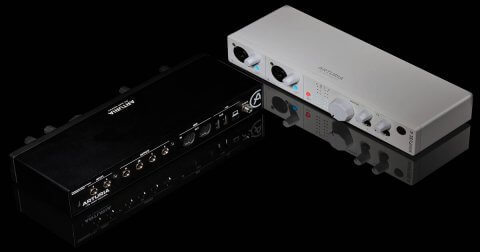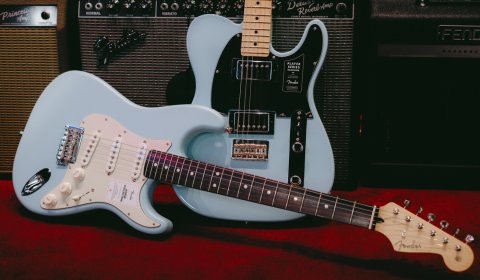Acoustic guitars have been around for hundreds of years and we’re not complaining – they sound sweet as heck! Bright and sonorous, it is hard to imagine music as we know it today without the instrument. However, the tone that comes out of the good ol’ musical box is a culmination of a variety of factors: wood selection, materials, craftsmanship, and construction methods. Today on Guitarology 101, we’re going to be writing about one of the most underrated aspects of acoustic guitar construction – acoustic guitar bracing!
What is acoustic guitar bracing?
Simply put, bracing refers to the patterns of wooden reinforcements that are glued on the inside of an acoustic guitar. While bracing is done to all parts of the guitar’s body (the top, sides, and back), the top tends to be the focus of luthiers and guitar players. Why? Because top bracing tends to affect the timbre and voice of an acoustic in the most material way!
What does acoustic guitar bracing do?
First and foremost, the main function of the bracing system is to support the structural integrity of the acoustic guitar. See all those taut strings on them? Those strings can exert up to 90 kilograms of tension on the acoustic guitar. Without the appropriate support, your acoustic guitar could and would self-implode under the stress needed for them to be heard. Talk about suffering for your art!
The bracing’s other purpose is also to control the movement of kinetic energy across the acoustic guitar’s top. See, when you strum or pick on the guitar, you’re putting energy into your guitar. This consequently causes the top to vibrate and produce a sound via the acoustic chamber in the guitar. How it vibrates and therefore, the tone your acoustic guitar produces is dictated by the manner in which it has been braced. The lack of bracing would result in a top that vibrates wildly – producing a chaotic and horrendous sound that would be unusable.
It is worth mentioning that the ideal physical characteristics of an acoustic top are lightweight, stiffness, and flexibility. Spruce, cedar, mahogany and maple are woods that are usually found as tops of acoustic guitars due to their inherent physical properties. A light and flexible top allows the guitar to be loud, that’s why luthiers strive to make the tops as thin as possible (thinner wood = more flexible). However, craft a top with too much flexibility and you’ll get a guitar that sustains like a wet rag.
With this in mind, you will definitely want to introduce some rigidity onto the top of the guitar. Having stiffness on your guitar top allows for your notes to sustain and sing. At the same time, you don’t want to go overboard, as too much stiffness will cause your volume and dynamic range to dip drastically.
This antithetical relationship is the main reason why bracing is so integral to the sound of acoustic guitars. Having the right wooden support structures at the correct places optimizes the relationship between the stiffness and flexibility of the acoustic guitar’s top – creating a beautiful sound that carries both qualities while remaining controlled and focused.
Fan bracing

Image credits: Taylor Guitars
A method developed in the early 1800s by Antonio de Torres, fan bracing has a long and esteemed history in the realm of the classical guitar. These older guitars were equipped with gut strings (fun fact: gut strings were made of real animal guts), which transitioned over to nylon strings as material science improved in the 20th century.
The one commonality between gut and nylon strings both have is the fact that they do not exert a huge amount of tension on the guitar. Commonly used classical guitar strings usually have a pulling force of around 35-45 kilograms – around half of what most steel-strings dish out. With this in mind, classical and nylon string guitar luthiers are allowed to get away with making thinner tops with lighter bracing patterns.
While there are many variations to ladder bracing, the main tenet they all seem to follow is that they:
- Consist of a common pattern of a series of thin braces that fan out from the soundhole towards the lower sections of the acoustic guitar, and
- Are installed to closely follow the grain of the wood.
How do they sound like: Tonally, fan-braced guitars have a warm and earthy sound that complements the mellow characteristic of nylon strings. As the tops and bracing tends to be thinner with this style of bracing, you’ll also get an instrument that is more responsive and has a larger dynamic range.
If you’re interested in having a look at what fan-braced guitars look like, check our nylon acoustic guitars out!
X bracing
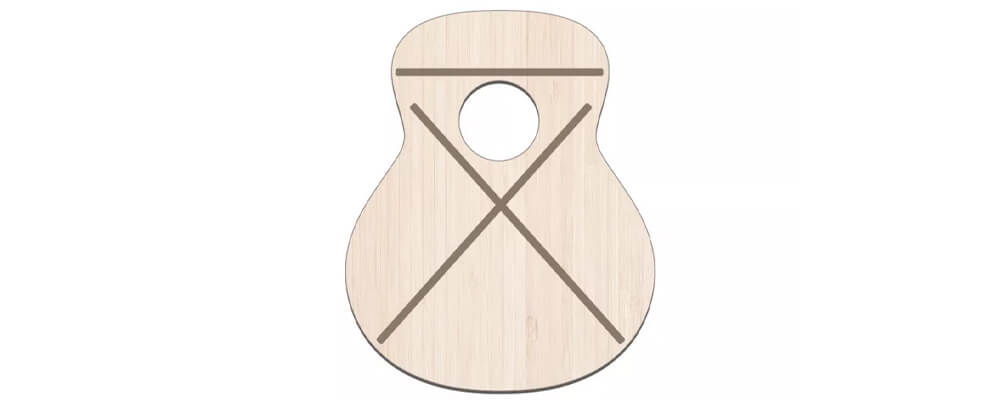
Image credits: Taylor Guitars
We’re moving to the mid-1800s in order to talk about the next big revolution in guitar bracing. With demand for louder guitars growing during this time period, players started abandoning the more mellow nylon strings in favour of the bite of steel strings. However, as we explained earlier, steel strings put significantly more strain on the top (and entirety) of the instrument. So how did luthiers of the 19th century overcome this structural issue?
Enter the X-bracing system! The X-bracing system consists of two wooden braces crossing under either side of the soundhole and bridge – a pattern that has supports the majority of the guitar’s top from the added string tension. Modern variations of this bracing system may also include additional smaller struts that branch off from the two main braces and extra bracing on the bass side of the top – structures that compensate for the stronger forces of the thicker bass strings. There is also a wide thin brace that is commonly placed perpendicularly under the tongue of the fretboard for additional integrity.
While the tops of X-braced acoustic guitars are usually more rigid (thicker) than their fan-braced counterparts, the higher tension of steel strings allows more energy to be transferred into a guitar, resulting in a louder guitar.
How do they sound like: Tonally, most X-braced guitars have more pronounced treble and bass frequencies – with a sharper attack also due in part to the brighter jangle of the steel strings.
Even though this tried and tested design has been in existence for a good two hundred years now, it is still commonly seen on many contemporary guitars – due to its desirable and versatile sound profile. If you’re interested in X-braced guitars, check out some of our Gibson and Epiphone acoustics!
Ladder bracing

Here’s a type of bracing that held a large amount of prominence back in the 1800s, fell by the wayside, and then found resurgence due to a financial crisis. The story of the ladder bracing began back with Rene Lacote, a famous French luthier who made some of the best classical guitars for some of the most acclaimed guitarists of his day.
The brace design isn’t too far off what you’d expect a ladder to be – consisting of wooden struts glued (mostly) perpendicular to the grain of the soundboard. This laddered style was and still is a straightforward way to place the bracing under the top, due to its simplicity and rather strong support structure. However, this reinforcement system was displaced soon after the advent of the X-bracing system.
For one, X-braced guitars withstood the high tension of steel strings to a much greater degree. In addition, most guitarists also contend that the X-bracing led to a warmer tone and an all-around better sounding guitar. Hence, with the lessened demand for it, ladder bracing fell to obscurity… until the Great Depression.
The Great Depression was a dark time in history but it did help reintroduce one of the most iconic acoustic bracing styles back to a contemporary audience. Back in the midst of the financial crisis in the 1920s, Gibson Guitars were looking for a way to stay in business amid a challenging business climate. In light of this, Gibson introduced their Kalamazoo and Recording King lines at a less expensive price point due to the cost-effectiveness of ladder-bracing.
While these models were meant for beginners, the treble-friendly sound of these guitars became favoured by blues, folk and some country performers of the era.
How do they sound like: These instruments have been described as having tons of projection with ‘honky’ and ‘boxy’ tone – a sound that is prized by certain groups of acoustic guitar fans.
Today, some brands such as Waterloo Guitars (made by Collings Guitars) and Gibson (look for the L-Series) feature this form of bracing on some of their guitars.
V-Class bracing
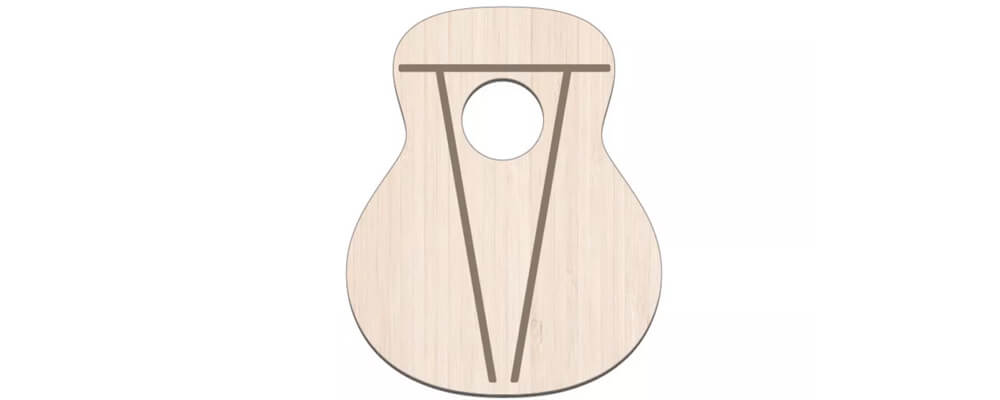
Image credits: Taylor Guitars
Don’t think that bracing design is a foregone conclusion – luthiers are still finding new ways to improve and squeeze out more acoustic performance anywhere they can. And that brings us nicely to Taylor Guitars.
Recognised as one of the most innovative acoustic guitar companies in the industry, Taylor Guitars has always been at the forefront of pioneering developments in acoustic guitar construction and material usage. Back in 2018, the company shook the guitar world with the announcement of its proprietary V-Class Bracing system. Conceptualised by their master guitar designer, Andy Powers, this triangle-shaped bracing pattern creates stiffness along the centerline of the guitar and flexibility across the soundboard, allowing both sides of the top to vibrate in an orderly fashion.
This allows for their guitars to have:
- More Volume – V-Class guitar bracing creates a more orderly rocking motion across both sides of the top, resulting in a controlled flexing movement that produces greater volume.
- Longer Sustain – The architecture of V-Class bracing creates stiffness along the middle of the guitar, in the direction of the strings. This rigidity keeps the strings in motion longer before fading out.
- Better Intonation – V-Class bracing eliminates much of the acoustic interference that causes some notes to waver and sound slightly out of tune. As a result, notes and chords played anywhere on the neck are more consistent and in tune with each other.
If you’d like to check out V-Class Bracing, look no further than our extensive collection of Taylor Guitars.
C-Class bracing
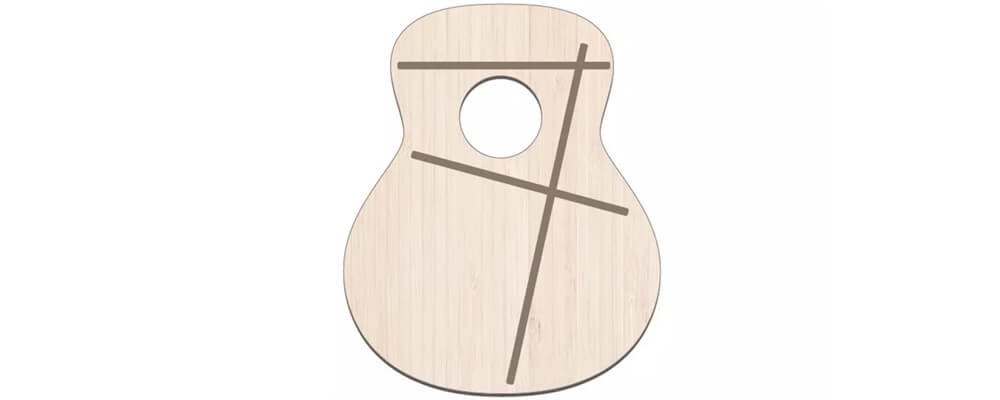
Image credits: Taylor Guitars
And so we’ve come to one of the most recent introductions to the bracing family tree – the C-Class bracing system.
Developed for the compact Taylor Grand Theater body shape by Andy Powers, Taylor’s proprietary C-Class features an asymmetrical, cantilevered design (hence the name C-Class). This unique bracing architecture emphasises the lower frequencies to produce a surprisingly powerful and warm bass response not usually found on smaller-bodied guitars.
Taking lessons from the development of their flagship V-Class bracing system, this brand new design promotes stiffness and flexibility in a way that ramps up the volume, increases sustain and improves intonation – all no mean feats considering the acoustic limitations that usually come with smaller-bodied guitars.
How do they sound like: Gone are thin and boxy sound profiles and in its place comes a sweet, focused and responsive voice, with a tonal output that punches way above its weight class.
As of now, the C-Class bracing system is only available on Taylor Guitar’s brand new Grand Theater series. If you’re in the market for a petite-sized guitar with loads of power, these immaculate acoustic might be a great place to start!
We hope you found this cursory introduction to acoustic guitar bracing beneficial to your guitar gear knowledge. Acoustic guitars are just magical instruments and there are just so many things that come into play when you’re trying to find the right one for yourself. Our advice? Come on down and try as many acoustics as you can. Try all construction types and see how they sound to your ears. At the end of the day, what your ears and hands tell you is all that matters!
If you’d like to shop our full range of acoustic guitars head over to our online store. If you’re looking for any guitar-related advice, you can always drop us a message and we’d be happy to help you out!
Read more: Guitarology 101: Acoustic Guitar – Laminates & Solid Wood
Banner image and illustration credits: Taylor Guitars


